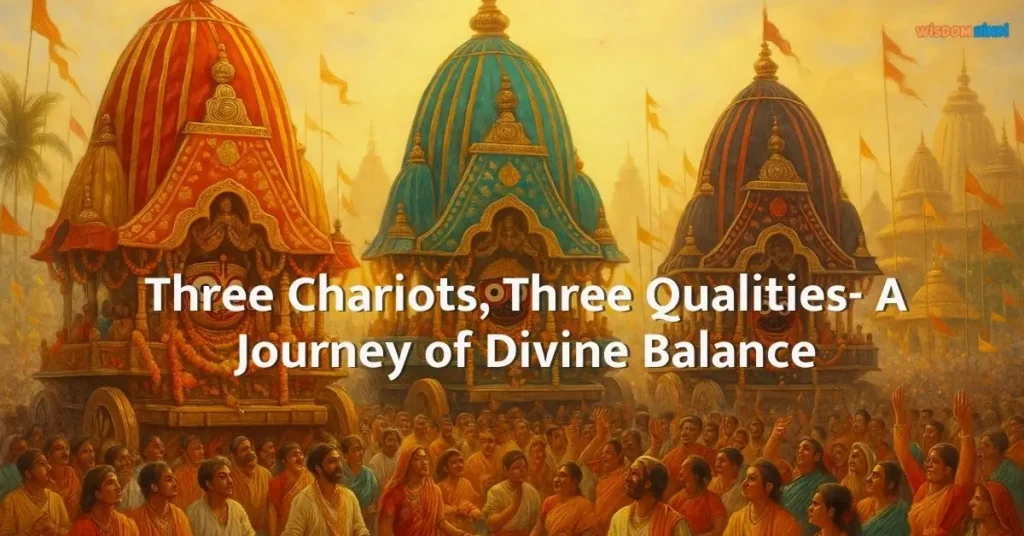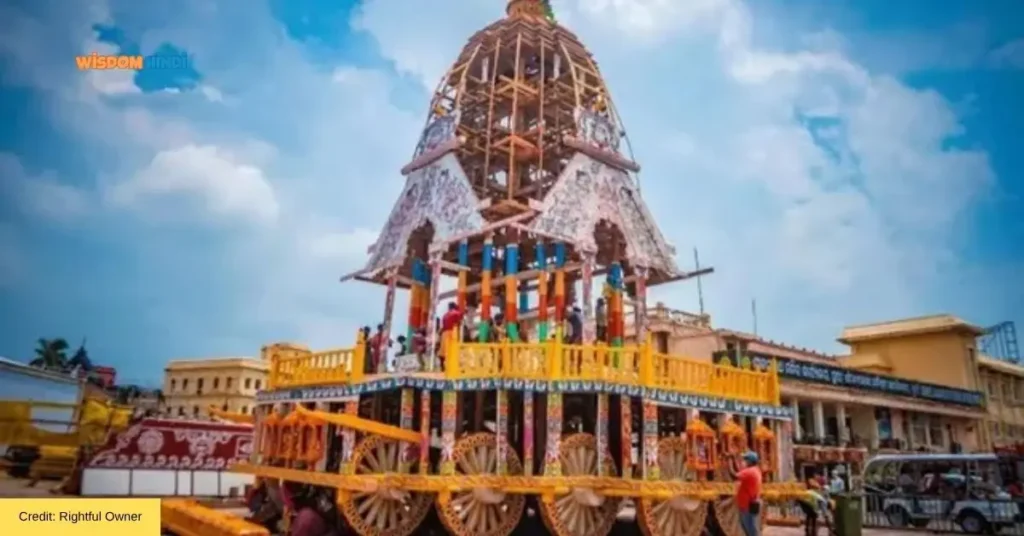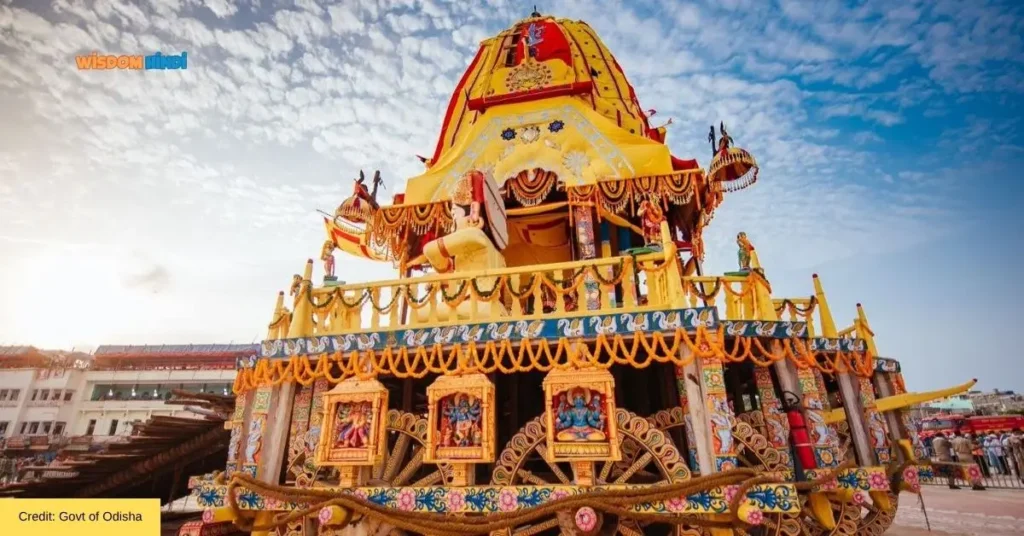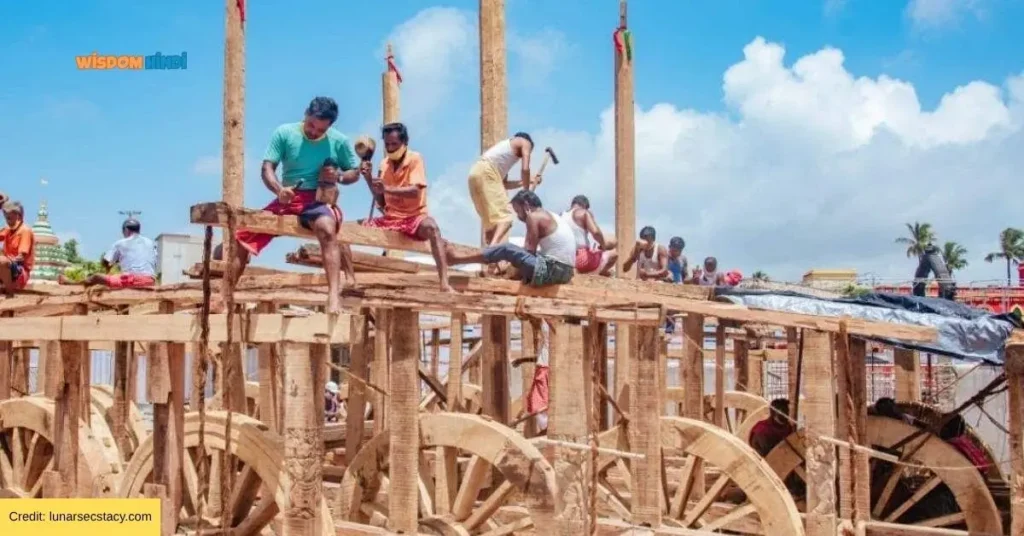
Jagannath Rath Yatra 2025: The world-famous Jagannath Rath Yatra of Lord Jagannath, his elder brother Balram, and sister Subhadra symbolize India’s culture, spirituality, and social unity. The most attractive aspect of this religious ritual is the three huge chariots in which the three deities sit and go out to tour the city among their devotees.
The three chariots are not just chariots, but they have a deep spiritual and philosophical meaning of their own, which is linked to the Tridev and Triguna principle. This article is based on the relation of the three chariots of Jagannath Rath Yatra 2025 with the Triguna principle. Along with this, we will also discuss in detail the tradition of construction of these chariots, the wood used in them, etc.
Spiritual secret of the three chariots
The use of three chariots in Jagannath Rath Yatra is not just a tradition but a symbol of Hindu philosophy and spirituality. These chariots are made for Lord Jagannath, Balabhadra, and Subhadra, and each chariot has its own identity, colour, symbol, and shape. According to the Puranas, this festival started when Subhadra expressed her desire to visit the city of Puri. To fulfill their sister’s wish, Lord Jagannath and Balabhadra toured the city on a chariot and stayed for a few days at the Gundicha Temple, which is believed to be their aunt’s house.
Read More: Pahandi Bije : The Secret Ritual of Lord Jagannath’s Grand Journey to His Devotees
The spiritual significance of the three chariots is associated with the Hindu Trinity of Brahma, Vishnu, and Mahesh as well as the Triguna principle of Sattva, Raja, and Tama. This principle is the basis of Indian philosophy which reflects the three fundamental qualities of nature and human life. Sattva Guna symbolizes purity, knowledge, and compassion. Rajo Guna symbolizes activity, passion, and drive, while Tamo Guna represents inertia, ignorance, and resistance to change. These qualities are symbolically represented through three chariots in the Rath Yatra-

Subhadra’s chariot Darpadalan symbol of Sattva Guna
In Jagannath Rath Yatra 2025, Subhadra’s chariot is called Darpadalan or Dev Dalan which represents Sattva Guna. Sattva Guna includes compassion, purity, and spirituality. Subhadra, the sister of Lord Krishna and the wife of Arjuna, is revered for her gentle and compassionate nature.
Her chariot, adorned in red and black hues, features the sacred symbol of the lotus, an emblem of purity and spiritual awakening. Lotus represents purity and spiritual advancement. This chariot runs in the middle of the Yatra which is a symbol of balance and harmony. Subhadra’s chariot, with its 12 wheels and a height of 42.32 feet, symbolizes the steadiness and serenity associated with Sattva Guna.
Balabhadra’s chariot Taladhwaj symbol of Rajo Guna
Lord Balabhadra’s chariot is called Taladhwaj. It is a symbol of Rajoguna. Rajoguna is related to action, movement, and creative energy. Balabhadra, the elder brother of Lord Krishna, is believed to be the incarnation of Sheshnag — embodying strength, stability, and divine protection. Balabhadra’s chariot is blue and green in colour which signifies life and energy. This chariot has 14 wheels and is 45 feet high which signifies the dynamism and power of Rajoguna. Taladhwaj leads the Rath Yatra which signifies the importance of action and leadership in life.
Jagannath’s chariot Nandighosh symbol of Tamoguna
Lord Jagannath’s chariot, known as Nandighosh or Garudadhwaj, symbolizes Tamoguna, representing divine stillness, mystery, and cosmic depth. Although Tamoguna is associated with stability, ignorance, and inactivity, in the context of Lord Jagannath, this guna signifies his universal and inclusive nature. Lord Jagannath, who is an incarnation of Lord Vishnu, is the savior of all beings and gives darshan to everyone without any discrimination.
Lord Jagannath’s chariot is red and yellow in colour which signifies enthusiasm and spiritual awakening. This chariot has 16 wheels and is 45 feet high. Nandi Ghosh walks at the back in Jagannath Rath Yatra which tells that the ultimate goal of all qualities is the refuge of God.

Triguna theory and spiritual meaning
In Hindu philosophy, the Triguna theory says that nature and human life are governed by the balance of three qualities – Sat, Raja, and Tama. The three chariots of the Jagannath Rath Yatra symbolize the three Gunas, highlighting their significance and the need for balance in human life. Subhadra’s chariot leads to knowledge and compassion (Sattva). Balabhadra’s chariot inspires action and movement (Raj) while Jagannath’s chariot binds everyone in the thread of unity and devotion (Tama).
Jagannath Rath Yatra 2025 spiritually symbolizes the journey of human life in which the devotee reaches God by balancing these three qualities. Subhadra’s chariot runs in the middle which shows that Sattva Guna creates a balance between Raja and Tama. This journey gives the message to the devotees that a balance of knowledge and compassion (Sattva), along with action (Raj) and rest (Tama), is necessary in life.
Apart from this, Rath Yatra also shows that God himself comes to his devotees. While devotees usually visit temples to seek the divine, during the Rath Yatra, Lord Jagannath, Balabhadra, and Subhadra themselves come out to bless the devotees with their divine darshan as they journey through the city. It shows his compassionate form which binds all beings in one thread through Tama Guna.
Tradition of building chariots
The construction of the chariots for the Jagannath Rath Yatra is a sacred and time-honored tradition that begins on the auspicious day of Akshaya Tritiya. Neem wood, called Daru, is used to build these chariots as neem is considered sacred and pure in Hinduism. This wood has medicinal properties and removes negative energy.
No nails, thorns, or metal of any kind are used in the construction of chariots, because according to the scriptures, the use of metal in spiritual work is considered inauspicious. The wooden pieces are connected with ropes and traditional techniques. Hundreds of wooden pieces are used in the construction of each chariot. Their number are respectively-
- Nandighosh (Chariot of Lord Jagannath) – Constructed using 832 wooden pieces, featuring 16 wheels, and standing 45 feet tall.
- Taladhwaj (Chariot of Lord Balabhadra) – Made from 763 wooden pieces, equipped with 14 wheels, and also 45 feet in height.
- Darpadalana (Chariot of Goddess Subhadra) – Built with 593 wooden pieces, has 12 wheels, and rises to a height of 42.32 feet.
These magnificent chariots are crafted by the skilled artisans of Puri, known as Vishwakarma Sevaks or Rupakar Sevaks. These artisans have been doing this holy work for many generations. The chariot construction takes more than two months, and during this time, the artisans work with full dedication and devotion. Various colors, flowers, birds, and patron deities are carved on the chariots, which makes them spiritually and culturally grand as well.

Disposal of chariot wood after the yatra
After the Jagannath Rath Yatra is over, the disposal of the chariot wood is also a part of the sacred process. Some parts of these chariots are auctioned and some wood is used in making prasad in the temple and other religious works. This tradition shows that every aspect of Rath Yatra is connected to spirituality and nothing is wasted in it.
Conclusion
Thus, in this article, we learned that the three chariots of Jagannath Rath Yatra are not only a part of the religious festival but also a deep symbol of the principle of the three qualities of Hinduism and spirituality. This gives the message that by maintaining a balance of Satva, Raja, and Tama in life, the devotee can reach the refuge of God.
FAQ- Jagannath Rath Yatra 2025
What do the three chariots of Lord Jagannath Rath Yatra symbolize?
The three chariots of Lord Jagannath Rath Yatra are symbols of the three qualities of human life and nature, Sat, Raja, and Tama.
1 thought on “When The Lord Comes to His Devotees – The Deeper Meaning Behind the Three Chariots of Rath Yatra”